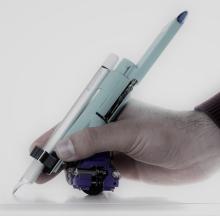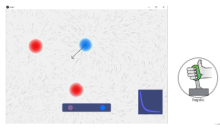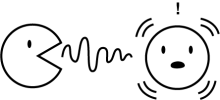CALMER, the non-Mom
Designed as a bland, unobtrusive appliance, Calmer is a bed for premature infants that replicates mothers' breathing movement and heart rate.

Designed as a bland, unobtrusive appliance, Calmer is a bed for premature infants that replicates mothers' breathing movement and heart rate.

Inspired by needs for haptic support of large motions on a surface (in embodied conceptual learning, commercial design, and 2D virtual / augmented reality), we present the ballpoint drive. This novel approach circumvents conventional constraints by imposing a new one: motion restricted to rolling on an arbitrary two dimensional surface, and grounding forces generated through friction.

Educational haptic platforms can leverage various modalities in order create effective interactive environments that can support embodied physical interactions. These platforms have the potential to leverage a student’s physical intuition to make abstract topics in physics, math, and other fields of science more concrete.

Direct manual cues, such as touching an interlocutor's face while they talk, can enhance the intelligibility of their speech. We aim to investigate the feasibility of using vibrotactile feedback to enhance speech intelligibility in acoustically noisy environments.

People describe vibrations using emotional descriptions. For example, signals can feel more or less "lively" than others. Can this language be used to stylize vibrations to feel more/less along certain emotional dimensions?

Voodle is an interface that uses vocal input to design haptic behaviour.
Macaron is a free, open-source, online haptic editor. Designed to be an easy-to-use tool for anyone working with haptics, it is a platform for experimenting with new haptic design features and has helped us understand how examples aid the haptic design process.

Crowdsourcing can gather rapid feedback at scale, but how do we crowdsource a haptic prototype? Haptic proxies are visualizations and simplified phone vibrations that can be used to represent high-fidelity haptics in studies conducted using Mechanical Turk.

Embodied, physical interaction can improve learning by making abstractions concrete. We use DIY haptic devices to move hands-on learning online.

People differ widely in how they perceive and want to use tactile signals. What kind of tools are needed to support them in customizing?
